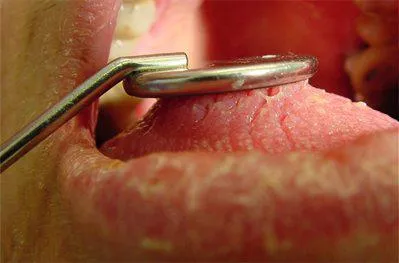06 November 2017
King's Study Provides Clues to Body's Defense against Common Oral Infection
An international team, co-led by researchers at King’s College London and the University of Pittsburgh, has identified the mechanism by which the immune system first learns that the fungus Candida albicans, which causes oral thrush, has invaded the body. The culprit is a fungal peptide toxin called Candidalysin, which punches holes in cells lining the mouth and is sensed by the immune system, which then begins to mount a defense.

The new findings, published today in the journal Science Immunology, could eventually lead to better treatments for oral thrush, which can produce pain severe enough to cause difficulty eating and swallowing, as well as other serious fungal infections.
“The mouth is home to a large number of microbes, termed commensals, which are harmless in healthy individuals. However, suppression of the immune system can lead to severe and reoccurring painful oral infections from these organisms,” explained the study’s co-senior author Julian Naglik, who is Professor of Fungal Pathogenesis and Immunology at King’s College London Dental Institute.
One such example is the fungus Candida albicans. The harmless commensal form exists as a small single-celled organism, but when the immune system is compromised, Candida elongates into an invasive form, characterized by long filaments called hyphae, that causes a pervasive infection called oral candidiasis, or “thrush.”
The immature immune systems of infants make them particularly susceptible to thrush, which can lead to a failure to thrive and nutritional deficiencies. The infection also is prevalent among HIV/AIDS patients, denture wearers and those on immunosuppressants, including chemotherapy and drugs to prevent the rejection of transplanted organs. In fact, at least 50 percent of HIV patients struggle with repeated thrush infections.
“However, surprisingly little is known about how fungal immunity in the mouth operates, and, until now, it was unclear why Candida does not establish an invasive infection in healthy humans,” said the study’s other co-senior author Sarah L. Gaffen from the University of Pittsburgh School of Medicine.
Her lab previously showed that an immune hormone called interleukin-17 (IL-17) and the specific cells that make it — a subclass of immune cells called helper T cells — are essential to immunity against oral thrush.
Oral epithelial cells, which are part of the mucous membrane lining the inside of the mouth, are the first cells in the body to encounter Candida. They ignore the yeast until it begins to grow hyphae, at which point the epithelial cells stimulate helper T cells to produce IL-17.
In the new study, the researchers used a combination of human oral epithelial cells cultured in laboratory dishes and mice infected orally with Candida, to show the central importance of Candidalysin, a peptide toxin secreted by Candida that allows the fungus to create holes in epithelial cells and invade the tissue. Further experiments revealed that IL-17 and Candidalysin act in a synergistic manner to amplify antifungal signals in cultured epithelial cells.
Candidalysin was discovered in 2016 by Professor Naglik at King’s College London, and is the first peptide toxin identified in any fungus that infects humans.
“To use a Game of Thrones analogy: the oral epithelial cells form a protective ‘wall’ that keeps the marauding Candida invaders at bay. Patrolling the wall are the helper T cells, which use IL-17 as their weapon to protect the kingdom” said the paper’s first author, Postdoctoral Fellow Akash Verma, Ph.D.
Despite millions of fungal infections worldwide, there are no commercially available anti-fungal vaccines. “Our research provides vital clues to understand the immune defence network at barrier sites of the body. This knowledge may ultimately be harnessed to design antifungal vaccines,” Professor Naglik said.
Gaffen and Naglik recently were awarded a large National Institutes of Health(NIH) grant to further explore the role of Candidalysin signalling in oral immunity. The grant received the prestigious MERIT designation given to only 5 percent of grants.
Additional authors on the study are: Chunsheng Zhou, B.S., Bianca Coleman, M.S., Kritika Ramani, Ph.D., Mandy McGeachy, Ph.D., Lawrence Kane, Ph.D., and Partha Biswas, Ph.D., all of Pitt; Jonathan Richardson, Ph.D., David Moyes, Ph.D., and Jemima Ho, Ph.D., of King’s College London; Anna Huppler, M.D., of the Medical College of Wisconsin; Ilgiz Mufazalov, Ph.D., and Ari Waisman, Ph.D., of University Medical Centre of Johannes-Gutenberg University, Germany; and Bernhard Hube, Ph.D., Leibniz Institute for Natural Product Research and Infection Biology, Hans Knoell Institute, Germany.
Funding was provided by the Medical Research (MR/M011372/1), Biotechnology & Biological Sciences Research Council (BB/N014677/1), and the National Institute for Health Research at Guys and St Thomas's NHS Foundation Trust, and King's College London Biomedical Research Centre (IS-BRC-1215-20006).
Papers mentioned in this article:
Oral epithelial cells orchestrate innate Type 17 responses to Candida albicans through the virulence factor Candidalysin published in Science Immunologyon Friday 3 November, 1400 ET

